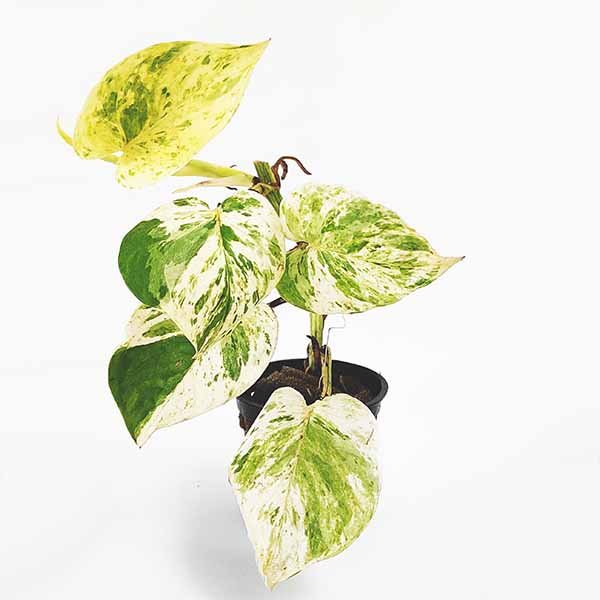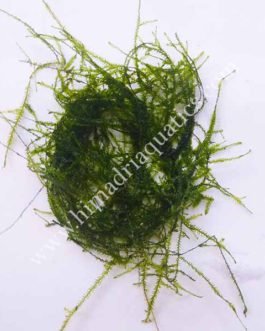Marble queen pothos (pot)
Original price was: ₹130.₹49Current price is: ₹49.
247 in stock
Description
Quantity: A stem in a pot
Perhaps one of the most common (and easy to care for) houseplants available, the marble queen pothos (Epipremnum aureum ‘Marble Queen’) is a variety of pothos that is characterized by vining foliage that has beautiful white and cream variegation. Similar to other common varieties of pothos, the marble queen pothos grows well indoors and can adapt to a range of growing conditions, making it versatile and perfect for beginners.
Unfortunately, marble queen pothos are considered mildly toxic to cats, dogs, and humans if ingested1. Take caution with this pothos if you have pets or young children at home.
Botanical Name Epipremnum aureum ‘Marble Queen’
Common Name Marble queen pothos
Family Araceae
Plant Type Perennial, vine
Mature Size 10 ft long, 3 ft wide (indoors)
Sun Exposure Partial
Soil Type Loamy, moist but well-draining
Soil pH Acidic
Bloom Time Spring, summer
Flower Color Green, white
Hardiness Zones 11a, 11b, 12a, 12b
Native Area Australia
Marble Queen Pothos Care
This highly variegated pothos is versatile, forgiving, and easy to grow. They can grow well in nearly any space in your home, and don’t require things like regular pruning or repotting in order to thrive. In fact, marble queen pothos enjoy being slightly rootbound, and should only need to be repotted once every couple of years.
While marble queen pothos can flower, it is rare to see them flower indoors and their flowers are fairly insignificant compared to their stunning foliage anyways. However, if you are lucky enough to see one, it is a great sign that your pothos is happy and thriving under your care.
Marble queen pothos plant with cream and light green variegated leaves
The Spruce / Phoebe Cheong
Marble queen pothos plant with cream and green variegated leaves closeup
Light
As with most pothos, marble queen pothos do best with bright, indirect light. They can tolerate some periods of direct morning or evening light, but generally you should avoid exposing your marble queen pothos to direct sunlight.
Soil
Generally, marble queen pothos can do well in a variety of soil conditions as long as the soil is well-draining and loamy. They are commonly grown in standard indoor potting soil, which is readily available at most plant stores and greenhouses. However, you can also make your own soil mixture by combining one part potting soil, one part perlite, and one part orchid bark for a light and airy soil mixture that your pothos will thrive in.
Water
Marble queen pothos enjoy consistent watering, but are also relatively drought tolerant—so don’t panic if you forget the occasional watering! Ideally, they should be watered once the top 2 to 3 inches of soil has dried out.
Temperature and Humidity
Marble queen pothos make ideal houseplants because they thrive in standard household temperature and humidity levels. They are not cold-tolerant plants, so avoid exposing them to temperatures below 55 degrees Fahrenheit (13 degrees Celsius). While not required, providing your marble queen pothos with some extra humidity will help encourage strong, vigorous growth. They grow well in humid rooms such as kitchens or bathrooms, or you can place them near a humidifier or on a pebble tray to provide them with a bit of extra humidity.
Fertilizer
Fertilizer is optional, but not required for marble queen pothos. As long as they are planted in a loamy potting material they should have the nutrients they require in order to grow. That being said, providing them with regular fertilization during the growing period can help to encourage strong growth and is never a bad idea. If desired, fertilize your marble queen pothos once a month during the spring and summer with a balanced liquid fertilizer.
Propagating Marble Queen Pothos
Marble queen pothos can be easily propagated by stem cuttings, which is a great way to encourage fuller growth on your existing plant, or create new plants to share with friends. To propagate your marble queen pothos, follow these steps:
Take stem cuttings from your plant that have at least 4-5 nodes on each cutting.
Remove the bottom 2-3 leaves from each cutting to expose the nodes, leaving at least 2 leaves at the top of the cuttings.
Place your cuttings in a glass jar filled with water, ensuring that the bottom of the cuttings are submerged, while the leaves on the top of the cuttings remain above the water.
Place the jar(s) in a location that receives medium to bright indirect light, and change the water every week to keep it fresh. Roots should begin to grow after 2-3 weeks of the cuttings being in the water.
Once the roots are at least 1 inch long, the cuttings can be re-planted in soil. You can add them back to the original plant, or create new plants at this time. Plant the cuttings in pre-moistened soil and pat them firmly into place.
Put the cuttings back in a spot that receives medium to bright indirect light, and keep the soil consistently moist for the first 1-2 weeks after planting to help the cuttings re-acclimate to soil.
Common Pests & Plant Diseases
Marble queen pothos are susceptible to a few common pests and diseases, namely common houseplant pests such as mealybugs, scale, fungus gnats, and spider mites, along with root rot. Regularly inspecting your plant for signs of pests is the best way to prevent full-blown infestations. Avoid overwatering your plant and ensure that your potting container has adequate drainage in order to prevent root rot.
Common Problems With Marble Queen Pothos
Generally, marble queen pothos are low-maintenance, problem-free houseplants. However, issues can arise if you are not watering your plant correctly, or if it is not receiving enough light. Two common problems that you may notice with your marble queen pothos are browning leaves and yellowing leaves.
Browning Leaves
Browning leaves are usually a result of under-watering or a lack of humidity. Ensure that you are providing your pothos with regular watering, and avoid placing it in locations that are overly dry, like near a drafty window or heating vent.
Yellow Leaves
The leaves on your marble queen pothos will start to turn yellow if you have overwatered your plant, exposed it to too much direct sunlight, or if you have not provided your plant with enough sunlight. This can be a tricky one to diagnose, but take stock of your current care routine for your plant and see which scenario is the likely culprit.
FAQ
Why is the white variegation on my marble queen pothos turning yellow?
If you notice that your white variegation is turning yellow, this means your plant is reverting and it needs more light in order to keep its bright white coloring.
Should I use a trellis or moss pole for my marble queen pothos?
This is optional and depends on how you want to display your pothos! Marble queen pothos can grow well on supports like a moss pole or trellis, or they can be grown as hanging plants, it is really up to you.
Should I mist my marble queen pothos?
While these pothos can benefit from some extra humidity, misting is actually not an effective way to increase humidity around the plant. Instead, misting tends to just make the leaves temporarily wet, which can lead to bacterial infections. If you’d like to increase the humidity around your plant, consider placing a humidifier nearby, or moving your pothos to a humid room in your home like a laundry room, kitchen, or bathroom.
1 review for Marble queen pothos (pot)
Only logged in customers who have purchased this product may leave a review.









Manjeet Kaur (verified owner) –
Very well packaged and looked healthy and good